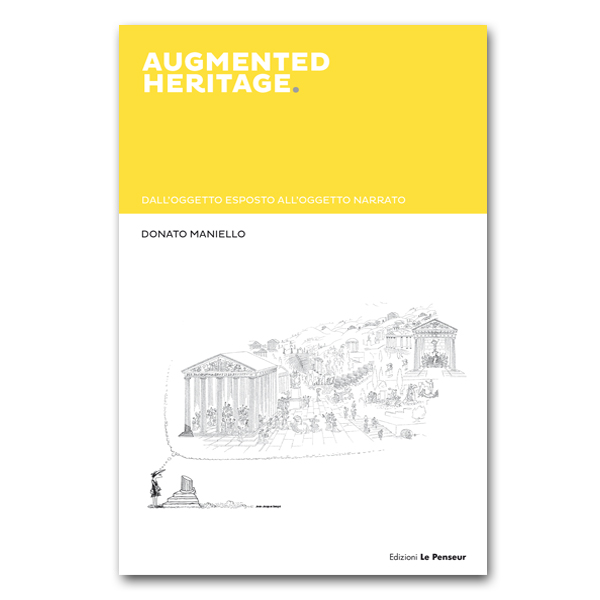2021 ITALIAN EditION

In quanti modi è possibile "aumentare" la realtà? La tecnologia è l'unico modo in cui è possibile raggiungere questo obiettivo? E' possibile parlare di etica digitale applicata ai beni culturali? Nella prima parte del volume l'autore affronta queste tematiche in un percorso sistematico analizzandone le reciproche influenze per poi introdurre la Spatial Augmented Reality (SAR), affrontando - in modo teorico - i metodi ad oggi disponibili con cui è possibile far coincidere scena reale e modello digitale attraverso l'approccio video proiettivo. La seconda parte è dedicata all'approfondimento della SAR sul patrimonio artistico e culturale, analizzando la parte di progettazione teorica che ha ispirato le istallazioni, curate dallo stesso autore. Il volume si rivolge infine a tutti gli studiosi di tecnologie dell'informazione che vogliano avere un approfondimento sistematico, teorico e di indirizzo su tale disciplina, attraverso uno sguardo quanto più ampio possibile sui metodi cuturali della progettazione multimediale.
2019 English EditION

This volume presents organically and as comprehensively as possible the techniques that, even if not properly designed for SAR, have been used in the sector with excellent results. The aim and common thread of the speech is their use to design entertainment; in fact, they allow to have a powerful communication tool that can be molded on any type of surface, but this implies a great responsibility in terms of message, quality and science, especially when to be involved and the cultural good.Video projection means communication but to do so correctly and need to know the tools we have available so as to have clear its limits and potential. In this regard, the book is intended to be a sort of laboratory from which the reader can make their own the experiences of the author, draw knowledge and deepen arguments, and then design their own intervention.Finally, since the success of a multimedia installation cannot be separated from the audio aspect, a specific chapter, by the sound designer Luca Canciello, introduces the player in the articulated world of sound and its design.
2019 English EditION

This volume is intended to be an exhaustive guide for all those who, already masters the basic techniques of video mapping, want to deepen the subject and in particular want to focus attention on the Spatial Augmented Reality (SAR) applied to cultural heritage, whether artistic, archaeological or museological.SAR offers in this sector great unexplored opportunities, especially if you think of its hybridization with traditional museographic systems or with more futuristic mixed reality systems; it is often configured as the best action to be interpreted to communicate the past as it frees the user from the brightness of other systems.The text, starting from a quick overview of the current technologies that are laying the foundations for those of the future, addresses the advanced techniques of surface acquisition and then move on to the theme of modeling and MadMapper, currently the only software with specific functions for video mapping. The last chapter is finally dedicated to the theme of augmented heritage and focuses attention on the use of multimedia procedures for the communication of cultural heritage with digital technologies both audio and video.
2018 italian edition

I metodi base e avanzati relativi alle tecniche di S.A.R. ampiamente illustrati nei volumi precedenti, spesso utilizzati in sinergia tra di loro, hanno permesso di comprendere le modalità attraverso cui è possibile ottenere il matching tra modello reale e virtuale. Ciò è reso possibile grazie alle maschere di livello, che rappresentano il fulcro centrale per la creazione dei contenuti multimediali. Il presente volume ha come fine quello di esporre in maniera organica tecniche che, anche se non nate propriamente per la S.A.R. sono state utilizzate in questo settore con ottimi risultati. Questi contenuti serviranno per progettare “l'entertainment” (il divertimento) al fine “educational” (educativo) in quanto consentono di avere un potente strumento di comunicazione plasmabile su ogni tipo di superficie.
2018 italian edition

La realtà spaziale aumentata offre nel settore dei beni culturali grandi potenzialità ancora non del tutto esplorate, sopratutto se si pensa ad una sua ibridazione con i sistemi museografici tradizionali o con i sistemi più avveniristici di mixed reality, e spesso si configura come l'azione migliore da intraprendere per comunicare il passato in quanto libera il fruitore dalla macchinosità di altri sistemi meno inclusivi.
2015 english edition

This book, the first in a series, dedicated to New Technologies for the Arts, is aimed at all digital arts students (PC and MAC users) who want to try video mapping for the first time. Thanks to a course of reading that alternates theoretic concepts and practical exercises – explaining from how to take a photograph to how to request permission, from the layer masks to 2D and 3D animation, up to the final projection and warping – the reader will be able to project a video mapping event.
2014 italian edition

Il libro, primo della serie, dedicato alle Nuove Tecnologie per l’Arte, è rivolto a tutti gli studiosi (PC e MAC users) di arti digitali che desiderano approcciarsi per la prima volta al video mapping. Grazie ad un percorso di lettura che alterna concetti teorici ad esercitazioni pratiche – che spiega da come scattare una foto a come richiedere dei permessi, dalle maschere di livello alle animazioni 2D e 3D fino alla proiezione finale e warping – il lettore sarà in grado di progettare un evento di video mapping.